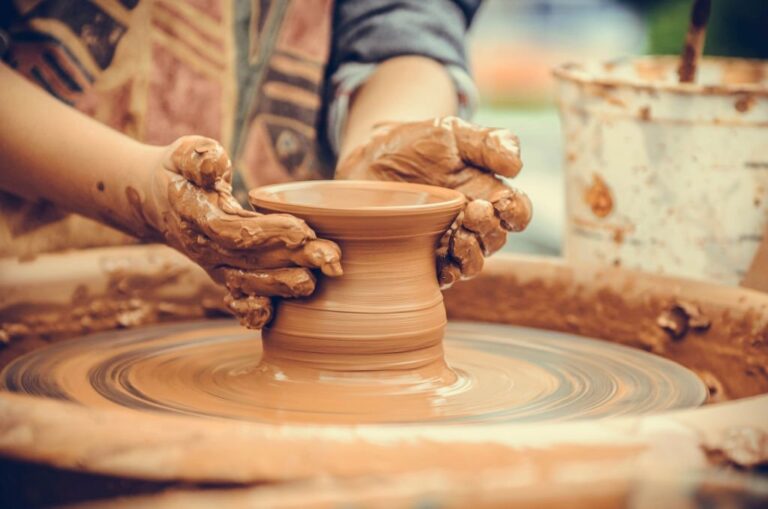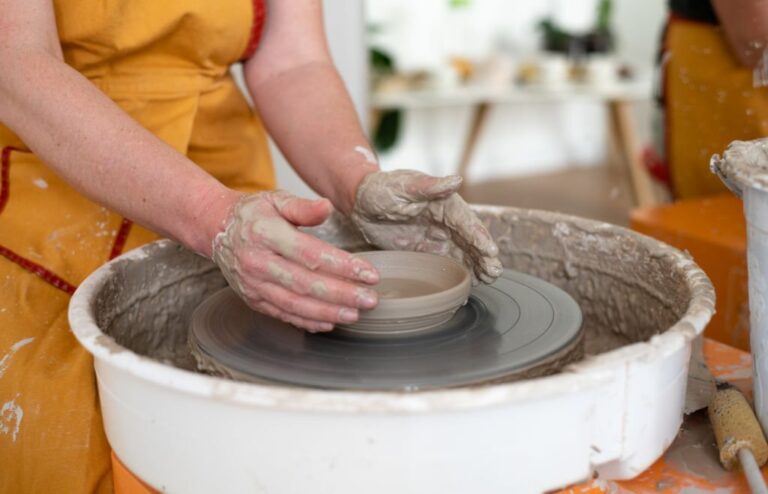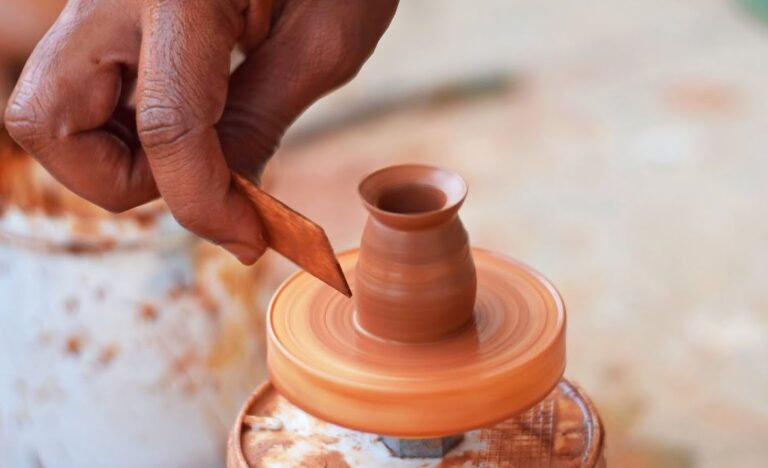Unlocking the Mystery: How to Tell Age of Marshall Pottery
To tell the age of marshall pottery, look for the maker’s mark and compare it to online references or collector’s guides. Marshall pottery marks have changed over the years, so identifying the specific mark can help determine the age of the piece.
Marshall pottery has been a popular choice for collectors for over a century. Established in 1895, the texas-based company has been producing high-quality pottery for over 125 years. With such a long history, it’s not surprising that collectors often find themselves wondering how to determine the age of a particular piece of marshall pottery.
Fortunately, there are a few simple steps you can take to identify the age of your pottery, including examining the maker’s mark, checking for specific design features, and consulting collector’s guides. By following these steps, you can enjoy collecting marshall pottery pieces while also learning about the company’s rich history.
Traditional Methods Of Age Determination
Methods Used By Collectors And Appraisers
Antique pieces, such as pottery, have a fascinating history. Several traditional methods are used by collectors and appraisers to determine the age of marshall pottery. The following are some of the most popular ones:
- Marks and labels: Marshall pottery pieces are often marked and labeled. These may include the company’s logo, manufacturing location, year code, artist signature, or patent number. Appraisers check these marks to determine the production date of the piece.
- Glaze color and texture analysis: The color and texture of the glaze used on a piece can reveal a lot about its age. In marshall pottery pieces, for example, the early glazes were typically thinner and smoother, while later glazes were thicker and had a more textured feel.
- Mold identification: The type of mold used to create the pottery piece can provide important clues about its age. For example, the older molds tended to have more intricate designs than the newer ones.
Limitations Of Traditional Methods
While traditional methods such as the ones mentioned above can be useful in determining the age of marshall pottery, they do have some limitations:
- Inconsistent markings: Not all marshall pottery pieces have clear marks or labels, and some may be difficult to decipher. This can make it challenging to accurately determine their age.
- Reproductions: Reproductions of popular marshall pottery pieces are common and can be difficult to distinguish from the real antique pieces.
- Limited scope: Traditional methods can only provide a general range of the production date for the piece. For a more precise date, additional research and analysis may be required.
Examples Of Misidentifications
Even the most experienced collectors and appraisers can make mistakes when attempting to identify the age of marshall pottery. Some examples of misidentifications include:
- Misreading marks: Misreading the company logos or other marks on a piece can lead to incorrect age identifications.
- Reproductions: Mistaking a reproduction for an antique piece can result in inaccurate age identification.
- Fakes: Some unscrupulous individuals create fake antique marshall pottery pieces, which can be almost impossible to detect without significant analysis.
Determining the age of marshall pottery pieces may be challenging, but with a combination of traditional methods and careful analysis, it is possible to unlock the history behind these beautiful pieces.
Understanding Marshall Pottery Marks
Marshall pottery is a well-known manufacturer of pottery located in marshall, texas. Their products are widely popular, and if you own a piece of their pottery, it’s crucial to know how to tell its age. Understanding marshall pottery marks is a valuable skill that can help you identify the age and authenticity of your piece.
Here are the key points to keep in mind when understanding marshall pottery marks:
- Marshall pottery marks are typically found on the bottom of the pottery piece and can be either hand-incised or stamped.
- The most common marshall pottery mark is the cursive “m” with “marshall texas” written underneath it.
- Other marks include a straight “marshall” mark and a script “marshall” mark with a circle around it.
Evolution Of Marshall Pottery Marks Over Time
Marshall pottery has been manufacturing pottery since the early 1900s, and their marks have evolved over the years. Knowing the different markings used during different times can help you pinpoint the age of your pottery piece.
Here are the key points to keep in mind when looking at the evolution of marshall pottery marks:
- The earliest marshall pottery marks were hand-incised and typically included the year and the potter’s initials.
- In the 1940s and 1950s, the cursive “m” with “marshall texas” written underneath it became the most commonly used mark.
- In the 1960s and 1970s, a straight “marshall” mark and a script “marshall” mark with a circle around it were used.
- In the 1980s and 1990s, the marks became simpler and more uniform, with just the cursive “m” being used.
Identification Of Genuine Vs. Fake Marks
As with any valuable collectible, there is always a risk of counterfeit or fake pieces. It’s important to know how to identify genuine marshall pottery marks to ensure that you are purchasing an authentic piece.
Here are the key points to keep in mind when identifying genuine vs. Fake marshall pottery marks:
- Look for consistent and accurate markings. If the markings are sloppy or inconsistent, it’s a red flag that the piece may not be genuine.
- Check the age of your piece against the known timeline of marshall pottery marks. If the marking doesn’t match the time period, it could be a fake.
- Check for other signs of authenticity, such as the quality of the piece, the pottery glaze color, and the weight of the piece.
Understanding marshall pottery marks is essential for anyone who collects or owns their products. By knowing the key points of their markings, the evolution of their marks over time, and how to identify genuine vs. Fake marks, you can confidently determine the age and authenticity of your piece.
Clues In The Design Of Marshall Pottery
Marshall pottery is a well-known american ceramic company with a rich history dating back to the early 1890s. If you’re a collector or enthusiast, knowing the age of a marshall pottery piece is crucial. While identifying the age can be a challenge, there are some clues in the design that you can use as a guide.
We will explore the significance of glaze color and texture, distinctive shapes and patterns, and tracing the evolution of designs over time.
The Significance Of Glaze Color And Texture
Glaze color and texture are key indicators of the age of marshall pottery. The color of the glaze, for instance, could vary from piece to piece and over time. Here are some of the colors to look for:
- Early marshall pottery pieces had a brown or ochre colored glaze
- 1920s pieces were glazed in cobalt blue
- After the 1940s, pieces were glazed in muted greens, blues, and grays.
- The most common texture for early pieces was a pebbled texture, while pieces from the 1940s were smoother and had a glossy finish.
Distinctive Shapes And Patterns
Another clue to dating marshall pottery pieces is the shape and pattern of the pottery. Here are some distinctive shapes and patterns to look for:
- Early pieces were hand-thrown, with simple glazes and decorations
- 1920s pieces often featured a classic art deco design, with bold colors and sharp geometric patterns.
- From the 1940s, there was a move towards more intricate designs, with hand-painted florals and other decorative motifs.
- The most popular marshall pottery designs were the butter churn, crock, and a variety of bowls with different patterns and sizes.
Tracing The Evolution Of Designs Over Time
One important way to identify the age of marshall pottery is to trace the evolution of its designs over time. By studying the pottery patterns, glaze color and texture, and the overall style of the pottery, you can largely identify if it’s from the 1890s, 1920s, or 1940s.
- Early marshall pottery pieces had straight sides and vertical ribs, while 1920s pieces often had a rounded shape.
- The use of cobalt blue on 1920s pieces and muted greens, blues and grays on post-1940s pieces reflects the general color palette in use during that time period.
- The use of intricate designs and decorations in post-war pieces, including florals, birds, and fruits, also reflects the changing design trends of the era.
Identifying the age of marshall pottery is a complex process, but by looking at the glaze color and texture, distinctive shapes, and patterns, and tracing the evolution of designs, you can gain a reasonable estimate of the age of a piece.
By following these simple steps, you can soon become an expert in identifying marshall pottery.
Scientific Techniques For Determining Age
Determining the age of marshall pottery is essential for collectors, historians, and pottery enthusiasts. While a visual inspection can provide some clues, scientific techniques can provide much more accurate and reliable information. We will explain some of the most common scientific methods used to determine the age of marshall pottery.
Radiocarbon Dating Of Organic Materials
Radiocarbon dating is a widely used method for determining the age of organic materials. This method is based on the fact that a certain amount of carbon-14 is present in the atmosphere, and this carbon-14 is taken up by plants during photosynthesis.
When animals eat these plants, they also absorb carbon-14. After death, the amount of carbon-14 in an organism gradually decreases over time through radioactive decay.
To determine the age of marshall pottery, scientists can extract organic materials embedded in the pottery, such as charred plant remains or bone fragments, and use radiocarbon dating to measure the amount of carbon-14 remaining in the sample. The result can provide a fairly accurate estimate of when the pottery was made.
Thermoluminescence Dating Of Pottery
Thermoluminescence dating is another method used for determining the age of pottery. This method is based on the fact that natural minerals, such as quartz and feldspar, accumulate radiation over time. When the pottery is fired in a kiln, the radiation is released, and the minerals begin to emit light.
By measuring the amount of light emitted, scientists can determine how long ago the pottery was fired.
To use this method, the scientist must extract a tiny sample from the pottery and heat it to release the radiation. The resulting light emission is measured and calibrated with the known radiation levels for the region. The result can provide a highly accurate estimate of when the pottery was fired.
Esr Dating Of Pottery And Minerals
Electron spin resonance (esr) dating is a method used for dating minerals or pottery that have been exposed to radiation. This method measures the number of electrons that have been excited to a higher energy level by the radiation. As these electrons gradually return to their original energy level, they emit a signal that can be measured.
To use this method, a scientist must extract a small sample of the pottery or mineral and measure the number of electrons that have been excited by the radiation. By comparing this result to the known levels of radiation exposure for the region, a fairly accurate estimate of the age can be obtained.
Advantages And Limitations Of Scientific Dating Methods
While scientific dating methods can provide highly accurate estimates of the age of marshall pottery, they also have limitations. Here are some of the advantages and limitations of these methods:
Advantages:
- Highly accurate and reliable estimates of age
- Can be used to corroborate or refute visual cues
- Can help to establish a broader context for the pottery’s creation
Limitations:
- Costly and time-consuming
- May require the destruction of a small sample of the pottery
- Results may be affected by contamination or other factors
Scientific techniques for determining the age of marshall pottery can provide much more accurate and reliable information than visual cues alone. Radiocarbon dating, thermoluminescence dating, and esr dating are just a few of the methods that can be used for this purpose.
While these methods have their limitations, they represent some of the most powerful tools for understanding the age and history of this important pottery.
Frequently Asked Questions For How To Tell Age Of Marshall Pottery
How Old Is Marshall Pottery?
Marshall pottery was established in 1895, making it over 125 years old today.
What Is Marshall Pottery Known For?
Marshall pottery is best known for its signature ceramic pots, which are handcrafted with local clay and made to last.
How Can I Tell The Age Of My Marshall Pottery?
You can tell the age of your marshall pottery by looking for specific markings or stamps on the piece. Factors like glaze and design may also offer clues.
Is Marshall Pottery Still In Business?
Yes, marshall pottery is still in business and remains a popular destination for tourists and collectors.
Where Can I Buy Marshall Pottery?
You can purchase marshall pottery products directly from the company’s retail store in marshall, tx, or through authorized resellers online.
Conclusion
The age of marshall pottery can be difficult to determine, but with these tips and tricks, you should be able to identify the era in which your piece was made. Remember to pay attention to important details such as the shape, style, and material used – all of which can tell a unique story about the pottery’s history.
Additionally, don’t be afraid to do some research on different marks and labels commonly associated with marshall pottery. By taking the time to truly evaluate your piece, you’ll be able to make an educated guess about its age and origins.
Whether you’re a seasoned collector or a novice pottery enthusiast, learning how to tell the age of marshall pottery is an exciting adventure that can uncover a rich history of craftsmanship and artistry.



